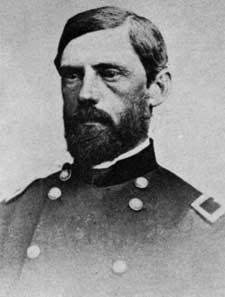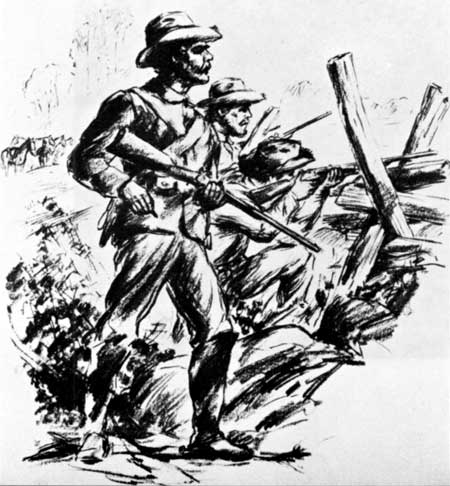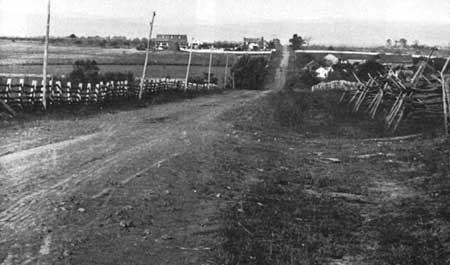|
GETTYSBURG National Military Park |
 |
 Maj. Gen. John F. Reynolds. Courtesy National Archives. |
 Lt. Gen. Ambrose P. Hill, Courtesy National Archives. |
The First Day
THE TWO ARMIES CONVERGE ON GETTYSBURG. The men of Heth's division, leading the Confederate advance across the mountain, reached Cashtown on June 29. Pettigrew's brigade was sent on to Gettysburg the following day to obtain supplies, but upon reaching the ridge a mile west of the town, they observed a column of Union cavalry approaching. Not having orders to bring on an engagement, Pettigrew withdrew to Cashtown.
In the intervening 2 days since he had assumed command of the Union forces, General Meade had moved his troops northward and instructed his engineers to survey a defensive battle position at Pipe Creek, near Taneytown, in northern Maryland. Buford's cavalry, which had effectively shadowed Lee's advance from the mountaintops of the Blue Ridge, was ordered to make a reconnaissance in the Gettysburg area. It was these troops that Pettigrew's men saw posted on the roads leading into the town, Neither Lee nor Meade yet foresaw Gettysburg as a field of battle, Each expected to take a strong defensive position and force his adversary to attack.

Cavalry outpost,
by Charles A. Morgenthaler.
A. P. Hill, in the absence of Lee, who was still beyond the mountains now took the initiative. At daybreak of July 1, he ordered the brigades of Archer and Davis, of Heth's division, to advance along the Chambersburg Road to Gettysburg for the purpose of testing the strength of the Union forces. As these troops reached Marsh Creek, 4 miles from Gettysburg, they were fired upon by Union cavalry pickets who hurriedly retired to inform their commander of the enemy's approach. In the meantime, Buford's division of cavalry had moved from their camp just southwest of Gettysburg to McPherson Ridge, a mile west of the town, Buford prepared to hold out against heavy odds until aid arrived. Thus subordinate field commanders had chosen the ground for battle.
It was 8 a. m.,July 1, when the two brigades of Archer and Davis, the former to the right and the latter to the left of the Chambersburg Road, deployed on Herr Ridge. Supported by Pegram's artillery, they charged down the long slope and across Willoughby Run against Buford's men. The cavalry had an advantage in their rapid-fire, breech-loading carbines. Dismounted, and fighting as infantrymen, they held their ground against the spirited attacks of Heth's superior numbers. At 10 o'clock timely aid arrived as troops from Gen. John F. Reynolds' First Infantry corps began streaming over Seminary Ridge from the south and relieved Buford's exhausted fighters. Calef's battery, one of whose guns had fired the first Union cannon shot at Gettysburg, was replaced by Hall's Maine artillery. But, in a few moments, Union joy at receiving aid was offset by tragedy. Reynolds, close to the front lines, was killed instantly by a sharpshooter's bullet.

Chambersburg Pike, looking westward from the Federal position
toward Herr Ridge, where the Confederate attack began.
The struggle increased in scope as more forces reached the field. When Archer's Confederates renewed the attack across Willoughby Run, Union troops of Meredith's Iron Brigade, arriving opportunely, struck the flank of the Confederates, routing them and capturing close to 100 men, including General Archer. Relieved from the threat south of the Chambersburg Pike, the 14th Brooklyn and 95th New York regiments shifted to the north of the Pike where the Confederates were overwhelming the Union defenders. With renewed effort, these troops, joined by Dawes' 6th Wisconsin, drove the Confederates steadily back, capturing 200 Mississippians in a railroad car. The Confederates then withdrew beyond striking distance, There was a lull in the fighting during the noon hour. The first encounter had given Union men confidence. They had held their ground against superior numbers and had captured Archer, a brigadier general, the first Confederate general officer taken since Lee assumed command.

|

|
|
Last Modified: Mon, Mar 4 2002 10:00:00 pm PDT |


